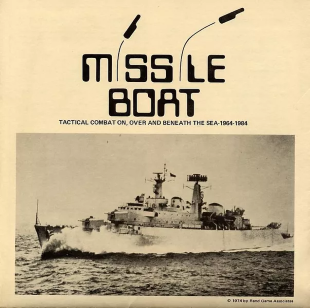
Azhanti High Lightning is a science-fiction wargame, designed by Frank Chadwick and Marc W. Miller, illustrated by Paul R. Banner, Charmaine Geist, Richard Hentz, and Richard Flory, and published by Game Designers Workshop (GDW) in 1980. The title is the name of the large military starship that provides the setting for close-action combat between individuals on board. Azhanti High Lightning is the fourth Traveller boardgame published by GDW. It was republished in 2004 as part of Far Future Enterprises's (FFE) Traveller: The Classic Games, Games 1-6+. Originally Supplement 5: Lightning Class Cruisers was only available as part of this game, it was republished in 2000 as part of FFE's Traveller Supplements volume.

Cry Havoc is a board wargame published by Standard Games and Publications in 1981 that uses a complex set of rules to simulate medieval one-on-one combat.

Bismarck is a board wargame published by Avalon Hill in 1962 that simulates the hunt for the Bismarck.

Star Patrol is a science fiction role-playing game published by Gamescience in 1977.

Chitin: I is a science fiction microgame published by Metagaming Concepts in 1977 in which bands of intelligent insects vie for resources.

StarGate is a science fiction board game published by Simulations Publications, Inc. (SPI) in 1979 in which players wage combat via spaceships.

Belter, subtitled "Mining the Asteroids, 2076", is a science fiction board game published by Game Designers' Workshop (GDW) in 1979.

Asteroid Zero-Four is a science fiction board wargame published by Task Force Games in 1979.

Freedom in the Galaxy, subtitled "The Star Rebellions, 5764 AD", is a space opera board game published by Simulations Publications, Inc. (SPI) in 1979.

Godsfire is a science fiction board wargame published by Metagaming Concepts in 1976 that simulates planetary empire building, economics, and diplomacy. The game was reissued by Task Force Games in 1985.

Ice War is a board wargame published by Metagaming Concepts in 1978 that hypothesizes a Eurasian attack against American oilfields in Alaska.

John Carter: Warlord of Mars is a two-player board game published by Simulations Publications, Inc. (SPI) in 1979 that is based on the Barsoom novels of Edgar Rice Burroughs featuring the hero John Carter.

Moon Base Clavius is a science fiction board wargame published by Task Force Games in 1981.

Bounty Hunter: Shootout at the Saloon is a combat picture book game published by Nova Game Designs in 1982 that simulates an Old West shootout between a lawman and an outlaw. The game uses two picture books to delineate combat, similar to the air combat game Ace of Aces. Shootout at the Saloon was supposed to be the first in a series of Bounty Hunter games that would encompass an entire town, but critical reception and sales were tepid, and no further games in the line were published.

Arcola, The Battle for Italy 1796 is a board wargame published by Operational Studies Group (OSG) in 1979 and republished by Avalon Hill in 1983 that is a simulation of the Battle of Arcola between French and Austrian forces in 1796. The game was designed to tempt players to purchase OSG's previously published and larger wargame Napoleon in Italy.

KampfPanzer: Armored Combat, 1937–40 is a board wargame published by Simulations Publications Inc. (SPI) in 1973 that simulates the first battles involving battle tanks.

Kriegspiel is a board wargame published by Avalon Hill in 1970 that simulates a hypothetical war between two nations. Although the simple game sold well to new players, it received negative reviews by more experienced gamers.

MiG Killers is a board game published by Gamescience in 1977 that simulates combat between jet aircraft from 1945 to 1977.

Missile Boat, subtitled "Tactical Combat On, Over and Beneath the Sea 1964-1984", is a board game published by Rand Game Associates (RGA) in 1974 that simulates naval combat using ships and weaponry from the mid-1960s to the mid-1980s.

Mission Aloft is a board wargame published by Jim Bumpas in 1977 that simulates aerial missions against ground targets in the 1960s and 70s.




















